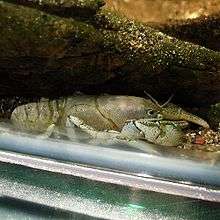Zarigani
| Cambaroides japonicus | |
|---|---|
 | |
| Scientific classification | |
| Kingdom: | Animalia |
| Phylum: | Arthropoda |
| Subphylum: | Crustacea |
| Class: | Malacostraca |
| Order: | Decapoda |
| Family: | Cambaridae |
| Genus: | Cambaroides |
| Species: | C. japonicus |
| Binomial name | |
| Cambaroides japonicus (De Haan, 1841) | |
Zarigani (Cambaroides japonicus) is a species of crayfish endemic to Japan.[2]
It is small in size (6 cm) and grayish in color. Its front claws are much weaker than those of other crayfish. Zarigani need low temperature and high water purity, so they live in upper streams of rivers or lakes in highland regions. The distribution of zarigani comprises Hokkaidō and northern Tōhoku (the northern area of Honshū).
The Environmental Agency (now Ministry of Environment) of Japan added it as a vulnerable species (IUCN category) to the Red Data List in 2000. It is thought that the causes of its decrease are corruption of water quality and the spread of the American crayfish Pacifastacus leniusculus, which was imported in the 20th century and has steadily proliferated in northern Japan.[3] Some suspect that this American crayfish carries some disease, such as the crayfish plague known in Europe, that eliminates zarigani.
References
- ↑ T. Kawai & Y. Machino (2010). "Cambaroides japonicus". IUCN Red List of Threatened Species. Version 3.1 (3.1). International Union for Conservation of Nature. Retrieved October 7, 2010.
- ↑ Tadashi Kawai & Gerhard Scholtz (2002). "Behavior of juveniles of the Japanese endemic species Cambaroides japonicus (Decapoda: Astacidea: Cambaridae), with observations on the position of the spermatophore attachment on adult females". Journal of Crustacean Biology. 22 (3): 532–537. doi:10.1651/0278-0372(2002)022[0532:BOJOTJ]2.0.CO;2. JSTOR 1549735.
- ↑ Kazuyoshi Nakata; Akira Tanaka & Seiji Goshima (2004). "Reproduction of the alien crayfish species Pacifastacus leniusculus in Lake Shikaribetsu, Hokkaido, Japan". Journal of Crustacean Biology. 24 (3): 496–501. doi:10.1651/C-2484.
